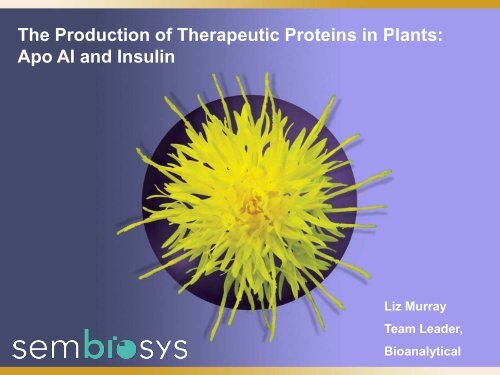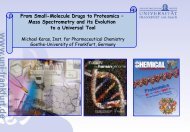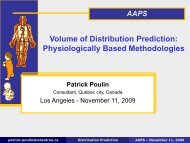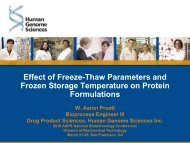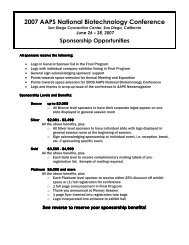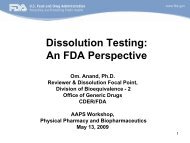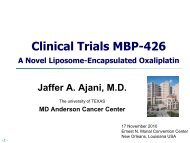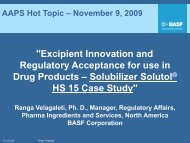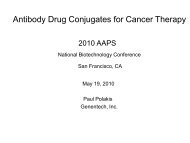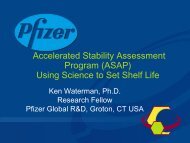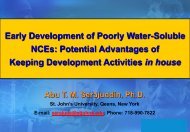The Production of Therapeutic Proteins in Plants: Apo AI and Insulin
The Production of Therapeutic Proteins in Plants: Apo AI and Insulin
The Production of Therapeutic Proteins in Plants: Apo AI and Insulin
You also want an ePaper? Increase the reach of your titles
YUMPU automatically turns print PDFs into web optimized ePapers that Google loves.
<strong>The</strong> <strong>Production</strong> <strong>of</strong> <strong>The</strong>rapeutic <strong>Prote<strong>in</strong>s</strong> <strong>in</strong> <strong>Plants</strong>:<strong>Apo</strong> <strong>AI</strong> <strong>and</strong> Insul<strong>in</strong>Liz MurrayTeam Leader,Bioanalytical
SemBioSys Genetics, Inc.SemBioSys Genetics, Inc. is a Canadian biotechnologycompany develop<strong>in</strong>g a broad pipel<strong>in</strong>e <strong>of</strong> prote<strong>in</strong>-basedpharmaceuticals <strong>and</strong> non-pharmaceutical productsus<strong>in</strong>g a safflower plant production system.
SemBioSys OverviewLocation: Calgary, Alberta, CanadaSymbol: SBS.TOEmployees: 35Patents: 170 issued93 pend<strong>in</strong>g
SemBioSys’ NicheSemBioSys focuses on f<strong>in</strong>d<strong>in</strong>g exist<strong>in</strong>g prote<strong>in</strong> based drugs<strong>of</strong> therapeutic <strong>in</strong>terest or other products such as specialty oilsfor which there is an unmet need.SemBioSys addresses dem<strong>and</strong>/prote<strong>in</strong> availability issueswith a lower cost production system. SemBioSys is aplatform technology company.
SemBioSys’ TechnologyPro<strong>of</strong>-<strong>of</strong>-ConceptArabidopsis thalianaCommercial <strong>Production</strong> SpeciesSafflower (Carthamus t<strong>in</strong>ctorius)
Transformation <strong>of</strong> SafflowerGerm<strong>in</strong>ationSeedselectionInfection <strong>of</strong>Cotyledons byAgrobacteriumAcclimationto SoilEarly stagegrowth – noselectionRoot<strong>in</strong>gShoot Elongation& Selection
Field Grown GMO SafflowerPlant<strong>in</strong>g sites: Alberta, United States <strong>and</strong> Chile -federal regulatory approval is required beforeplant<strong>in</strong>g each season.Isolation distances are required – 1600 m from othersafflower crops <strong>in</strong> Canada, 2 miles <strong>in</strong> the US.Seed is harvested <strong>and</strong> cleaned before use.
<strong>The</strong> Oilbody Technology PlatformSafflowerSeed<strong>Prote<strong>in</strong>s</strong>FloretOilbodies:Seed structures with aphospholipid membrane<strong>and</strong> prote<strong>in</strong> coat thatstore energy forgerm<strong>in</strong>ation <strong>in</strong> the form <strong>of</strong>oil, protect<strong>in</strong>g the oil fromoxidization <strong>and</strong>deteriorationOleos<strong>in</strong>Oleosome
Purification <strong>of</strong> Oilbodies<strong>The</strong> Process: flotation-centrifugation to separate theoilbody fraction
Plant Impurity Assays – HCP <strong>and</strong> Oleos<strong>in</strong>Rabbit anti-host cell prote<strong>in</strong> antibodies were raised to thesoluble <strong>and</strong> oilbody fractions <strong>of</strong> safflower seed gr<strong>in</strong>dpreparations.Antibodies were supplemented with other polyclonals thatrecognized oilbody prote<strong>in</strong>s for the ELISA.Limit <strong>of</strong> Detection =
Plant Impurity AssaysPhytate (IP 6 ) is the plant’s phosphate storage molecule<strong>and</strong> requires phytase to release the phosphate.Phytate is an anti-nutrient – will b<strong>in</strong>d important m<strong>in</strong>erals<strong>in</strong> the body such as calcium, z<strong>in</strong>c <strong>and</strong> iron.Phytate is assayed by digestion with phytase thenquantitation <strong>of</strong> phosphate us<strong>in</strong>g a commercial phosphateassay reagent (Bio-Mol Green) <strong>in</strong> a microplate format(620 nm).Limit <strong>of</strong> Detection =
Plant Impurity AssaysCarbohydrate – simple <strong>and</strong> complex, some unique to plants.Detected us<strong>in</strong>g an HPLC method <strong>in</strong>volv<strong>in</strong>g TFA hydrolysis<strong>of</strong> the prote<strong>in</strong> to release monosaccharides.Limit <strong>of</strong> Detection =
Product Impurity Assays – Fusion PartnerFusion partner - usually a s<strong>in</strong>gle cha<strong>in</strong> antibody (scFv) that<strong>in</strong>teracts with oleos<strong>in</strong> on the oilbody surface.Solubility issues are usually a problem with this once it iscleaved.Product is cleaved from the fusion partner us<strong>in</strong>g enzymes.Limit <strong>of</strong> Detection =
Other Impurity AssaysHeavy metals – present <strong>in</strong> soil, detected us<strong>in</strong>g ICP-MS(<strong>in</strong>ductively coupled plasma mass spectrometry).Pesticides – <strong>in</strong>clud<strong>in</strong>g herbicides, detected us<strong>in</strong>g st<strong>and</strong>ardagricultural methods us<strong>in</strong>g CFIA <strong>and</strong> EPA guidel<strong>in</strong>es.
Viral Load/Viral ClearanceRegulators recognize that plant associated viruses are <strong>of</strong> norisk to humans (EMEA CHMP/BWP/48316/2006). Accidentalviral contam<strong>in</strong>ation through agricultural practices is aconcern <strong>and</strong> must be addressed (i.e. animals, fertilizers, etc).Seed viral load - test<strong>in</strong>g <strong>of</strong> surface contam<strong>in</strong>ation for virusesViral clearance <strong>of</strong> process – test<strong>in</strong>g same as for any othermanufactur<strong>in</strong>g process.
Lead<strong>in</strong>g Product C<strong>and</strong>idatesProduct Indication Stage <strong>of</strong> DevelopmentPharmaceuticalBiosimilar Insul<strong>in</strong>(SBS-1000)<strong>Apo</strong> <strong>AI</strong> MilanoDiabetesAcute CoronarySyndrome(atherosclerosis)Phase I/II• SBS-1000 demonstrated to bebioequivalent to commerciallyavailable <strong>in</strong>sul<strong>in</strong>Precl<strong>in</strong>ical• Positive prelim<strong>in</strong>aryregression/remodel<strong>in</strong>g data• Pre-IND meet<strong>in</strong>g held Q3 2009
Insul<strong>in</strong>Positioned to Meet the Grow<strong>in</strong>g Dem<strong>and</strong>• Diabetes is a worldwide crisis• Increas<strong>in</strong>g emphasis on earlier use <strong>in</strong> Type 2 diabetes• Escalat<strong>in</strong>g dem<strong>and</strong> <strong>in</strong> the Develop<strong>in</strong>g World will further outstrip supply
Biosimilar Insul<strong>in</strong> (SBS-1000)• Very well characterized biologic with establishedmonograph assays <strong>and</strong> reference st<strong>and</strong>ards• FTO – very little restrict<strong>in</strong>g <strong>in</strong>tellectual property• Unmet need – <strong>in</strong>creas<strong>in</strong>g <strong>in</strong>cidence <strong>of</strong> diabetesworld wide with limited supply• Reduced manufactur<strong>in</strong>g costs – allows accessibilityfor poorer countries
Economics <strong>of</strong> Plant-Produced Insul<strong>in</strong>SafflowerEnabl<strong>in</strong>g technology to meet<strong>in</strong>sul<strong>in</strong> dem<strong>and</strong>1.2 %~1.0<strong>in</strong>sul<strong>in</strong> expression <strong>of</strong>total seed prote<strong>in</strong>acre produces 1 kg <strong>of</strong> <strong>in</strong>sul<strong>in</strong>FloretSeed15,000acres to supply 2012projected <strong>in</strong>sul<strong>in</strong> dem<strong>and</strong>world-wide$80Mest. capital cost for 1,000 kg<strong>of</strong> plant-produced <strong>in</strong>sul<strong>in</strong>70%Capital costreductioncompared t<strong>of</strong>ermentation
Insul<strong>in</strong> – Expression <strong>in</strong> <strong>Plants</strong>Plant Transformation Vector for Insul<strong>in</strong>staRBphaPPRSscFvD9pVS1 reppSBS443812797 bpER-HInphaTbomoriSpecRLBubiTpatubiPDerived from an Agrobacterium plasmid us<strong>in</strong>g selection based on herbicide tolerance.Expression is targeted to the seed.1 st generation construct was not an oleos<strong>in</strong> fusion system.
Insul<strong>in</strong> – Equivalence DataV8 Protease F<strong>in</strong>gerpr<strong>in</strong>t<strong>in</strong>gHPLC Run Time (m<strong>in</strong>)USP Insul<strong>in</strong> (reference st<strong>and</strong>ard)SemBioSys Insul<strong>in</strong>V8 protease digest isdiagnostic for correctdisulfide b<strong>in</strong>d<strong>in</strong>g <strong>in</strong> <strong>in</strong>sul<strong>in</strong>
Insul<strong>in</strong> – Equivalence DataInsul<strong>in</strong> Receptor B<strong>in</strong>d<strong>in</strong>g Analysis <strong>of</strong> SBS-1000 DSIC50 Prediction Curves - Insul<strong>in</strong>300250USPy = 96415x -1.9211uU/ml <strong>in</strong>sul<strong>in</strong>20015010050SBS-1000y = 532058x -2.3245R 2 = 0.98R 2 = 0.96Humul<strong>in</strong>y = 201360x -2.1042R 2 = 0.98NIBSCy = 217904x -2.1133R 2 = 0.9800 10 20 30 40 50 60 70 80 90 100USP Humul<strong>in</strong> SBS-1000 NIBSC% no <strong>in</strong>sul<strong>in</strong> controlIC 50 value comparison (µU/ml)USPSBSInsul<strong>in</strong>NIBSCHRRatio toUSPRatio toNIBSCRatio toHR52.51 59.80 55.95 53.58 1.14 1.07 1.12
Insul<strong>in</strong> – Equivalence DataIGF-1 Receptor B<strong>in</strong>d<strong>in</strong>g Analysis <strong>of</strong> SBS-1000 DSIC50 Prediction Curves - IGF-1nM IGF10010IGF-1y = 27104x -2.3766R 2 = 0.98NIBSCy = 381217910928x -4.8196R 2 = 0.95USPy = 238270451661x -4.7054R 2 = 0.98SBS-1000y = 527721407540x -4.8927R 2 = 0.9610000100010010nM <strong>in</strong>sul<strong>in</strong>10 10 20 30 40 50 60 70 80 90 1001IGF-1 USP NIBSC SBS-1000% no lig<strong>and</strong> controlIC 50 value comparison (µU/ml)IGF-1SBSInsul<strong>in</strong>St<strong>and</strong>ardRatio toIGFRatio to Insul<strong>in</strong>St<strong>and</strong>ard2.48 2570 2471 1036 1.04 (NIBSC)2414 1.06 (USP)
Insul<strong>in</strong> – Equivalence DataRabbit Safflower Insul<strong>in</strong> Tolerance Test% Initial Blood Glucose10080604020June 2008Sal<strong>in</strong>eUSP Insul<strong>in</strong> (reference st<strong>and</strong>ard)Insul<strong>in</strong> (Humul<strong>in</strong> ® R - Eli Lilly)Insul<strong>in</strong> (SemBioSys)0 100 200M<strong>in</strong>utes Post Injection
Insul<strong>in</strong> Characterization: Cl<strong>in</strong>ical Bioequivalence250.0200.0Comparison <strong>of</strong> Blood Insul<strong>in</strong> Levels betweenSBS-1000 <strong>and</strong> Reference Insul<strong>in</strong>sHumul<strong>in</strong>® RHumul<strong>in</strong>® SSBS-1000150.0pmole/L*m<strong>in</strong>100.050.00.00 1 2 3 4 5 6 7 8 9Hours25
<strong>Apo</strong> <strong>AI</strong>Next Generation <strong>The</strong>rapy <strong>in</strong> AtherosclerosisStat<strong>in</strong>s (LDL therapy)Halts plaque build-up<strong>Apo</strong> <strong>AI</strong> (HDL therapy)Reverses plaque build-up
<strong>Apo</strong> <strong>AI</strong> Milano (SBS-2000)• FTO – SBS has the patents for expression <strong>of</strong> <strong>Apo</strong> <strong>AI</strong><strong>in</strong> plants• Volume/Dos<strong>in</strong>g – likely 50-100 mg/kg which meansseveral grams are required for each dose <strong>in</strong> eachperson• Manufactur<strong>in</strong>g – bacteria free system avoids the<strong>in</strong>teraction <strong>of</strong> <strong>Apo</strong> <strong>AI</strong> with bacterial endotox<strong>in</strong>•Unmet need – no drug on the market is able toreverse plaque buildup <strong>in</strong> blood vessels
Chemical Characterization <strong>of</strong> Purified <strong>Apo</strong> <strong>AI</strong> MilanoMS & N-term<strong>in</strong>al Sequenc<strong>in</strong>g<strong>Apo</strong> <strong>AI</strong> St<strong>and</strong>ardMassExpected 28078.6 DaObserved 28076.0 DaN-term<strong>in</strong>al SequenceExpected DEPPQObserved DEPPQMassSafflower <strong>Apo</strong> <strong>AI</strong> MilanoMassExpected 27781.3 DaObserved 27780.0 DaN-term<strong>in</strong>al SequenceExpected PPQSPObserved PPQSPMass
Functional Characterization <strong>of</strong> Purified <strong>Apo</strong> <strong>AI</strong> MilanoDMPC Clearance Assay1.2001.0000.800Abs @ 325 nm0.6000.4000.2000.0000 1 2 3 4 5 6 7 8 9 10 11 12 14 16 18 20 22 24 26 28 30Time (m<strong>in</strong>)DMPC (non red) <strong>Apo</strong><strong>AI</strong> (non red) SBS Milano (non red)
Cholesterol Efflux <strong>in</strong> vitro6.0In vitro Cholesterol Efflux5.0% efflux4.03.02.01.00.0no stimulation vehicle only <strong>Apo</strong> <strong>AI</strong> alone SBS <strong>Apo</strong> <strong>AI</strong> Milano Plasma HDLalone (native <strong>Apo</strong> <strong>AI</strong>)SBS <strong>Apo</strong> <strong>AI</strong> MilanoHDLTest article
Cholesterol Mobilization <strong>in</strong> vivoSBS <strong>Apo</strong> <strong>AI</strong> Milano HDLVehicle only4.0Total cholesterol (mmol/l)3.53.02.52.01.51.00.50.00 5 30M<strong>in</strong>utes
www.sembiosys.com
Non-Pharma ProductsProducts <strong>and</strong> Commercial PartnersGLA (omega-6 oil) - ArcadiaChymos<strong>in</strong> (prote<strong>in</strong>) - INDEARDHA (omega-3 oil) - MartekHydresiaTM (oilbodies) - Botaneco


